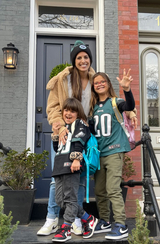Breaking Barriers: Isa’s Journey with Hip Dysplasia
Breaking Barriers: Isa’s Journey with Hip Dysplasia
11-year-old Isa enjoys horseback riding, archery and rock climbing – sports that at one time would not have been feasible for her. Isa was born with a rare, genetic condition, called brittle cornea syndrome, which can cause hip dysplasia among other symptoms. It wasn’t until Isa underwent a highly complex surgery at Children’s Hospital of Philadelphia (CHOP) that she was able to participate in the physical activities she now loves.
Isabella (“Isa”) was born seven weeks early. In the NICU, doctors noticed differences in her posture, eye color and white eye tissue (sclera). At a geneticist’s recommendation, Isa’s parents, Andrew and Jessica, had a genetic screening performed. The results showed a rare connective tissue disorder – brittle cornea syndrome (BCS) – which is most often discovered in adults after a trauma to the eye.
In addition to a thin and fragile cornea, BCS is associated with extremely flexible joints (also called hypermobility), a spine that doesn’t curve the way it should (kyphoscoliosis), hearing loss, and a hip socket that can’t support the hip joint (known as dysplasia). BCS has a number of other symptoms, but each individual is unique; not everyone experiences the same symptoms.
There is no cure for BCS, and treatment typically involves wearing glasses to prevent damage to the cornea, monitoring for vision and hearing issues and managing any other symptoms that may arise.
From screening to surgery

“Isa didn’t have a lot of problems at first,” says Jessica. Although Isa had hip dysplasia and started wearing protective glasses at 3 months old, the annual screenings she received showed no other symptoms of BCS.
However, at 6 years old, Isa began to have pain in her hips and trouble with her gait. She could walk, but she could no longer run.
An evaluation at the family’s home hospital showed Isa was developing severe hip dysplasia and would need surgery. After Isa underwent hip surgery without improvement, her surgeon recommended a second surgery. At this point, the couple began to seek a second opinion for their daughter’s care.
The U.S. News & World Report rankings led Andrew to contact CHOP’s best-in-nation Orthopedic Center, where the family consulted with Dr. Wudbhav N. Sankar, MD, Director of the Young Adult Hip Preservation Program.
Dr. Sankar agreed that Isa would need a second surgery and proposed a highly complex and technically challenging procedure, called a triple pelvic osteotomy, as an alternative option. The family ultimately chose to proceed with their current surgeon’s recommendation. After a second unsuccessful surgery, however, they decided it was time to transition to CHOP’s top-ranked orthopedic care.
The nation’s best orthopedic care

At CHOP, Jessica and Andrew met again with Dr. Sankar, who, after evaluating Isa, decided his original recommendation was the best course of action.
“Isa had complex hip dysplasia where her hip socket was shallow, and because of her hypermobility, she was actually dislocating her hip as she tried to walk and run,” says Dr. Sankar. “The triple osteotomy, a technically complex procedure performed at specialized centers like CHOP, allows the surgeon to turn the entire hip socket to correct the shallowness, stop the dislocations and preserve growth in the pelvis.”
Isa, however, having already undergone two surgeries, was anxious about another. Support from Dr. Sankar, the physical therapy team and Child Life helped to alleviate her fears.
“Dr. Sankar always talked directly to Isa,” says Jessica. “He made sure Isa understood the procedure and how it would help. She felt good that it was going to make a difference.”
Jessica and Andrew also felt supported by the Orthopedic team. “The Nurse Navigators, the PT team, they all provided everything we needed. It really made a difference for our family,” says Andrew.
Isa’s surgery was ultimately successful, and she is once again able to pursue the physical activities she enjoys, both in and outside of school. However, because BCS is the root cause of Isa’s condition, she may face future challenges. Her care teams – both at CHOP and at her home hospital – continue to monitor her health through annual screenings. In the meantime, Isa, a “super social, outgoing child,” loves Minecraft and spending time with her friends and 7-year-old sister, Penelope.
Says Jessica, “People often comment that Isa brings joyful energy wherever she goes.”
An unlikely connection
Through an online network focused on mentorship and support for people with hip dysplasia, Isa was coincidentally paired with another one of Dr. Sankar’s patients, now a college student. This older girl took Isa under her wing, mentoring her through the surgery and the healing process, and even attending all of Isa’s appointments.
“It was so important to her,” says Jessica.